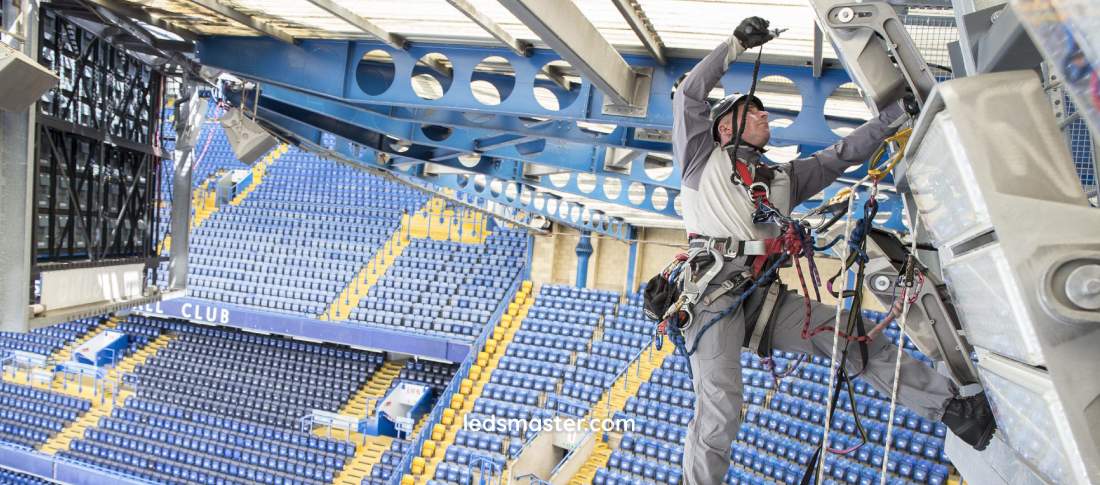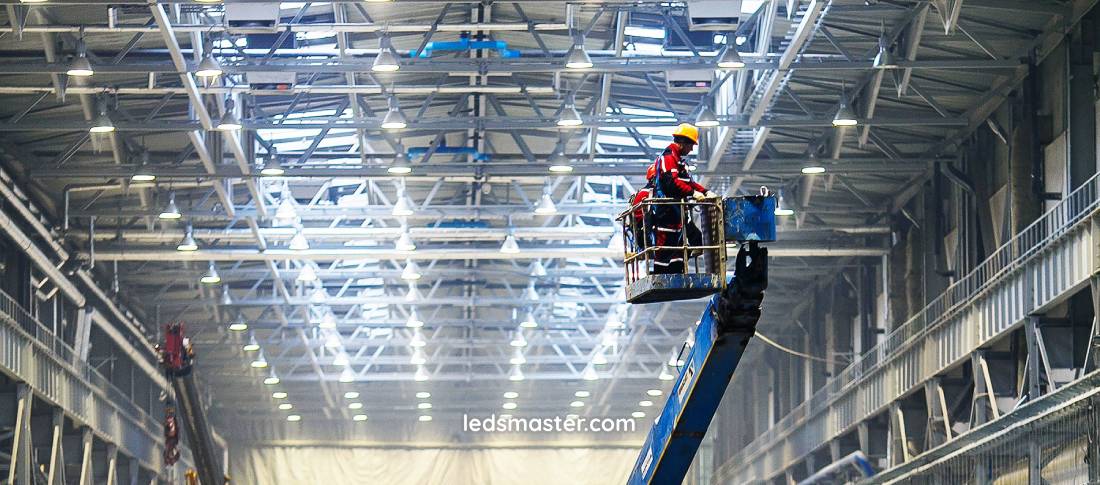
Lighting transforms our world, turning the ordinary into the extraordinary. Yet, behind every radiant glow and every shadow cast lies a secret: meticulous maintenance. Just as a skilled artist tends to their masterpiece, caring for your lighting ensures it shines at its brightest, creating spaces that inspire and uplift. Dive into the art of lighting maintenance, and discover how a little care can keep your environment illuminated with brilliance and vitality.
Get your complimentary lighting design today
Over time, lights can accumulate dust, suffer from wear and tear, or experience electrical issues. Without proper upkeep, these problems can lead to decreased lighting quality, higher energy consumption, and increased risk of malfunction or safety hazards. By implementing a routine maintenance schedule, you can address issues before they escalate, ensuring that your lighting systems perform at their best.
Table of Contents
ToggleLighting maintenance ensure that lighting systems function efficiently and safely over time. It encompasses a variety of tasks aimed at preventing malfunctions, addressing issues as they arise, and optimizing performance. Lighting maintenance can be categorized into two primary types: preventive maintenance and corrective maintenance. Each type plays a significant role in the longevity and efficiency of lighting systems, and understanding both can lead to better practices in maintaining these essential components of any facility or outdoor environment.

Preventive maintenance involves routine checks and cleaning tasks designed to avert potential issues before they arise. This proactive approach can significantly enhance the lifespan of lighting systems while reducing the likelihood of unexpected failures. The process includes various activities such as inspecting light fixtures, cleaning lenses and bulbs, and replacing filters. Implementing a robust preventive maintenance plan can mitigate risks and ensure that lighting remains reliable and efficient.
Routine inspections are a aspect of preventive maintenance. Regularly checking light fixtures enables the identification of various issues such as loose connections, damage, or signs of wear. Inspections should be systematic and thorough, examining all components of the lighting system, including lamps, ballasts, wiring, and fixtures. During these inspections, it is essential to ensure that fixtures are securely mounted and that no components are exposed to potential hazards.
For instance, when inspecting fixtures, look for signs of corrosion or rust, especially in outdoor environments where moisture can contribute to deterioration. Checking for dust accumulation on bulbs and lenses is also important, as this can significantly affect light output. By conducting routine inspections, facility managers can address minor issues before they escalate into significant problems that could disrupt lighting efficiency.
Cleaning is another task in maintaining lighting systems. Dust and debris can accumulate on light fixtures, lenses, and bulbs, which can significantly reduce the efficiency and brightness of the lights. For indoor lighting, cleaning should be performed periodically, utilizing appropriate cleaning solutions and tools to avoid damage. This may include using microfiber cloths or specialized cleaners designed for light fixtures. It is advisable to develop a cleaning schedule that corresponds with routine inspections, ensuring that all fixtures remain clean and functional.
Outdoor lighting, which is exposed to environmental elements, may require more frequent cleaning to prevent dirt and grime build-up that can impede performance. Seasonal changes can exacerbate the accumulation of debris, necessitating a more proactive cleaning approach during fall and spring. For example, leaves and pollen can gather on outdoor fixtures, reducing their effectiveness. By maintaining cleanliness, lighting systems can operate at optimal levels, providing the necessary illumination for safety and aesthetic purposes.
As time passes, light bulbs and fixtures will naturally wear out and require replacement. Prompt lamp replacement is necessary to avoid diminished lighting levels and potential safety hazards. When replacing bulbs, it is important to select the correct type and wattage specified for each fixture. Using the wrong type of bulb can lead to inefficiencies and may even damage the fixture. Adhering to the manufacturer’s specifications ensures that the lighting system operates as intended.
Additionally, fixtures themselves can also deteriorate over time due to exposure to environmental elements or physical damage. Regular inspections should focus on identifying signs of rust, corrosion, or structural damage. For instance, fixtures exposed to moisture may develop rust, while those in high-traffic areas might incur physical damage. When a fixture is found to be compromised, it should either be repaired or replaced promptly. Maintaining the quality of fixtures is essential not only for aesthetic purposes but also for preventing potential safety risks associated with electrical hazards or falling components.
Furthermore, it is advisable to keep a stock of replacement bulbs and fixtures on hand. This practice ensures that replacements can be made quickly and efficiently, minimizing downtime and maintaining adequate lighting levels. Establishing a clear replacement schedule based on the average lifespan of bulbs and fixtures can also help streamline this process, ensuring that the lighting system remains fully operational.
Electrical issues can pose challenges in lighting maintenance. Problems such as flickering lights, tripped circuit breakers, or faulty wiring require immediate attention to prevent further damage or safety concerns. Flickering lights may indicate issues such as loose connections or failing components, while tripped circuit breakers can signify overloads or short circuits. It is advisable to consult with a qualified electrician to diagnose and repair any electrical issues, as improper handling can lead to dangerous situations.
In addition to diagnosing visible issues, regular testing of circuits and connections can help identify potential problems before they manifest as significant malfunctions. This proactive approach not only helps maintain system integrity but also enhances safety by reducing the risk of electrical fires or shocks. Proper grounding and adherence to electrical codes are essential in ensuring the safety and reliability of lighting systems.
Moreover, incorporating surge protection can also be beneficial in protecting lighting systems from power surges caused by lightning strikes or other electrical disturbances. Surge protectors help safeguard the electrical components of lighting systems, minimizing the risk of damage and prolonging the lifespan of fixtures and bulbs.
Maintaining energy efficiency is a aspect of effective lighting maintenance. As technology continues to evolve, newer, more energy-efficient lighting solutions become available. Upgrading to LED lighting or implementing smart lighting controls can significantly reduce energy consumption and lower utility costs. Regularly reviewing and updating the lighting system to incorporate the latest energy-efficient technologies contributes to long-term savings and provides environmental benefits.
Transitioning to LED lighting can yield substantial energy savings due to their lower energy consumption and longer lifespan compared to traditional incandescent or fluorescent bulbs. LEDs consume up to 80% less energy than incandescent bulbs and can last up to 25 times longer. This longevity translates to reduced maintenance costs and fewer replacements over time. Furthermore, LEDs produce less heat, minimizing the risk of overheating fixtures and reducing cooling costs in indoor environments.
In addition to upgrading to energy-efficient bulbs, implementing smart lighting controls can enhance energy efficiency further. Smart controls allow for automation of lighting schedules, enabling lights to be turned off when not needed or dimmed during peak hours. Sensors can also be integrated to adjust lighting based on occupancy, ensuring that energy is not wasted in unoccupied spaces. Regularly reviewing energy usage and making adjustments based on usage patterns can optimize energy efficiency and lead to cost savings.
Lighting maintenance is influenced by seasonal and environmental factors. Outdoor lighting systems are particularly vulnerable to weather conditions, including rain, snow, and extreme temperatures, which can impact their performance and longevity. Regular inspections should be conducted to check for weather-related damage and ensure that fixtures are properly sealed and protected from the elements.
In colder climates, monitor for issues such as ice build-up or frost, which can obstruct light output and potentially damage fixtures. For instance, ice accumulation on fixtures can lead to increased weight and strain on mounting hardware, increasing the risk of structural failure. Conversely, in warmer climates, high temperatures may cause fixtures and bulbs to overheat, leading to premature failure. Ensuring proper ventilation around fixtures can help mitigate this risk.
Additionally, seasonal changes can impact the frequency and type of maintenance required. For example, during fall, outdoor fixtures may require more frequent cleaning to remove leaves and debris that can accumulate and block light output. Conversely, in spring, pollen and dust may necessitate additional cleaning efforts. Being proactive in addressing these environmental considerations helps prevent potential problems and extends the life of lighting systems.
Ensuring that maintenance activities are conducted safely requires using appropriate personal protective equipment and adhering to established procedures. For instance, when working with high or difficult-to-reach fixtures, it is essential to utilize proper ladders or lifts and to ensure that power is turned off before undertaking any maintenance tasks. This precaution helps to prevent electrical shocks and falls, which are common hazards in lighting maintenance.
Moreover, compliance with local regulations and standards maintain safe lighting systems. Lighting systems must meet specific codes related to safety, energy efficiency, and environmental impact. Regular reviews and updates of maintenance practices are advisable to ensure compliance with the latest regulations. This may involve keeping abreast of changes in building codes or safety regulations that impact lighting installations.
Additionally, it is beneficial to conduct safety training for personnel involved in lighting maintenance. Training can cover essential topics such as electrical safety, proper lifting techniques, and the use of personal protective equipment. A well-informed maintenance team is better equipped to perform tasks safely and effectively, thereby minimizing risks and ensuring compliance with safety standards.
Maintaining accurate records of lighting maintenance activities serves various purposes, including tracking performance, scheduling inspections, and planning upgrades. Documenting details such as maintenance dates, tasks performed, and any issues encountered can assist in identifying patterns and enhancing future maintenance strategies. A systematic approach to record-keeping allows for better resource allocation and more efficient planning of maintenance activities.
For example, documenting when bulbs were replaced or when fixtures were cleaned can help establish a maintenance schedule that optimizes the frequency of tasks based on actual usage and conditions. This data-driven approach can lead to more effective maintenance strategies, ultimately improving the reliability and performance of lighting systems.
Additionally, a well-maintained record is beneficial for audits, inspections, and assessing the need for system upgrades. When regulatory bodies or internal audits require documentation of maintenance practices, having organized records simplifies the process. Moreover, analyzing historical maintenance data can provide insights into trends and areas for improvement, enabling better planning and resource allocation.

Effective lighting maintenance ensure that lighting systems operate efficiently, safely, and economically. Implementing a comprehensive maintenance plan that includes routine inspections, cleaning, lamp and fixture replacement, and addressing electrical issues can enhance the performance and longevity of lighting systems.
Incorporating feedback from maintenance personnel can further refine the overall maintenance strategy. Those who perform the maintenance tasks often have valuable insights into the performance of lighting systems and the challenges encountered. Engaging with maintenance staff can lead to the identification of best practices and areas needing improvement, fostering a culture of continuous enhancement in lighting maintenance.
By adopting these practices, facilities can ensure that their lighting systems remain reliable and energy-efficient while aligning with current safety standards. Ultimately, this comprehensive approach to lighting maintenance contributes to a safer and more cost-effective lighting environment. The performance of lighting systems directly impacts not only safety and functionality but also the overall experience for those who utilize the spaces they illuminate.
This may involve attending industry seminars, participating in training sessions, or subscribing to relevant publications. Regularly reviewing and updating maintenance practices in light of these advancements ensures that lighting systems remain efficient and aligned with best practices.
Lighting maintenance encompasses a range of tasks aimed at optimizing performance and safety. By understanding the types of maintenance, conducting routine inspections, addressing electrical issues, and embracing energy-efficient technologies, facilities can ensure that their lighting systems operate effectively over time. Seasonal considerations, safety protocols, and thorough record-keeping contribute to a comprehensive maintenance strategy. Through ongoing evaluation and adaptation, organizations can enhance the reliability and longevity of their lighting systems while providing safe and inviting environments for occupants.